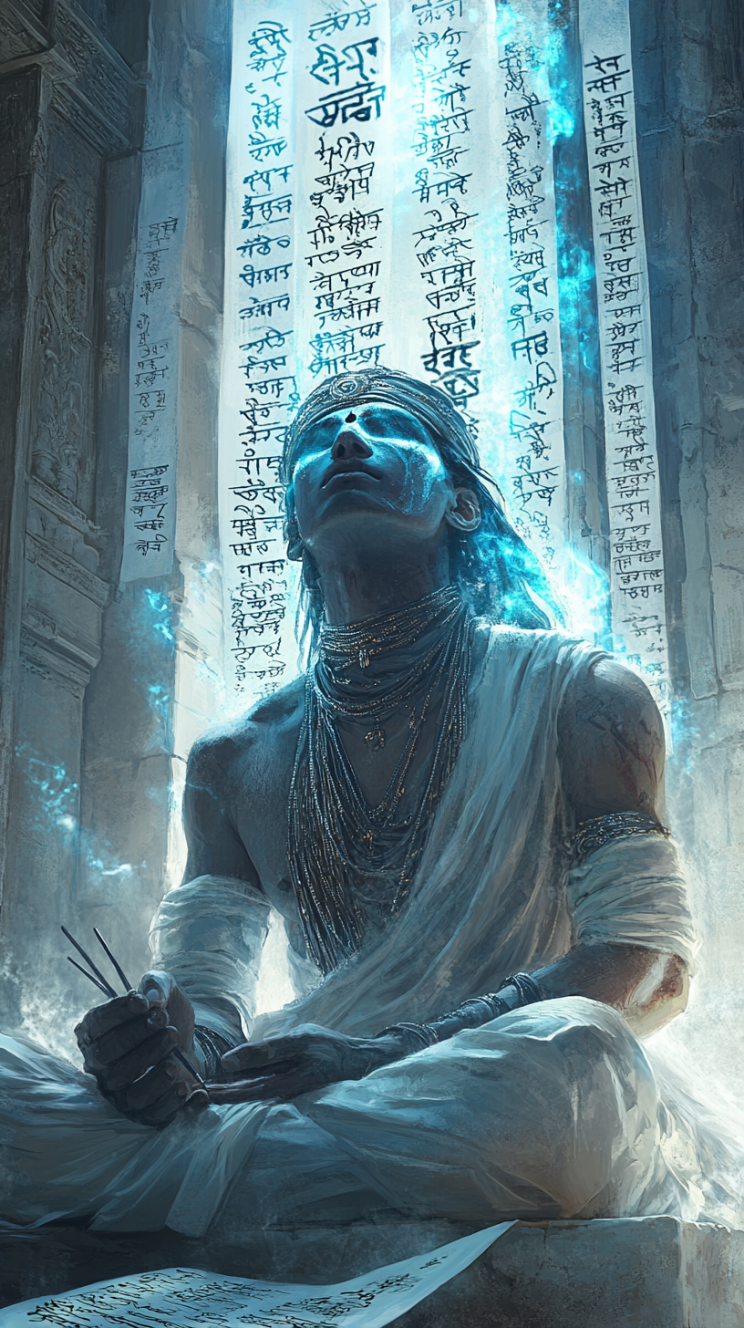Akhevik
You must not be speaking the things that are being the cause of your pain.Akhevik, or threadspeech, is a rare liturgical language spoken by the Chandravamshi. It is rarely used outside of their temples and religious ceremonies, yet the language itself has significantly influenced the naming of Chandrasma Archipelago, its islands, and the speech of those upon it.
It is presumed to have once derived from a now long-extinct human language spoken on what would become the Sunari Wilderness, and is evidenced to be linked with the Samsaran tongue by many words sharing similar roots between the two.
This is taken as a sign that the past of Sahasridvipa has long been joined to the samsarans, whose appearance is almost entirely by divine providence alone.
Akhevik speech is lilting and odd with its tenses, and those who speak it more than they ever speak their own languages are prone to falling into the Akhevik pattern of speech. When dealing with the Chandravamshi, odd speech patterns and unusual idioms are a sign that the individual in question was either raised in the religion or has adapted incredibly well to it.
Beyond the archipelago, few have even heard of Akhevik. No books exist to teach it, and given the challenges in escaping the archipelago, there are few teachers around to spread its use.
Adoption across Sahasridvipa
We do not speak the tongue of Fate's threads, but the wisdoms our priests bring are welcome among us!The regular folk of the archipelago (and indeed, of all the places the Chandravamshi have reached) have little reason to learn a sacred liturgical language used only for texts they will rarely have opportunity to access. Mostly, they speak Common or other regional languages. With that said, Akhevik has still influenced local speech through the idioms it uses. Akhevik idioms are often strange and offputting to those without any familiarity with the Chandravamshi and their bizarre method of speaking, but to the locals across the archipelago, they are welcome reminders of home. Many of the idioms formed in Akhevik are also based on aspects of the local surrounds, and so are doubly catchy to those in the area - even if they have absolutely no familiarity with the tongue itself. Some translated idioms include:
- "When no petals are shining..." meaning "Well, when there's no luck...", in reference to the belief that the many pearl-white shimmering flowers found across Nishamani close their petals when bad luck draws near.
- "The washing of the stone will be making smooth sands, but never can it be standing so tall as it was," which is more a grounded beach reference. While stones can be smoothed into perfect spheres or sands, doing so will erode their strength away - just as trying to smooth over mistakes will take away the strength of a relationship.
- "You are caring for a thread nobody else is sewing," which is to imply that the individual in question is dedicating so much time to something important to them alone. While this generally implies selfishness, it can also be used to imply that they are wasting their time or, if modified, that they have become someone that only a single person (such as a parent) could care for.
- "He is thinking to be drinking of the moon," which is a suggestion that the individual in question is going to attempt to drink a reflection - something he believes that is not true. It's often used to describe the gullible or foolish, but can also be used for those drowning in illusions or odd divinations.
Writing System
Ah, what is being the stroke order..?The writing system of Akhevik is one that the young acolytes speak of with dread. It requires the use of a special brush crafted specifically for the purpose of writing the language, and each acolyte is trained in making their own brushes before they are even allowed to begin practicing the written form. It is an artistic stroke-based language that demands calligraphic flair, ill-suited to small lettering or to too-casual a hand. Unlike some languages, the written form of Akhevik was actually developed prior to the spoken.
History tells that it came about through an oracle's hand: the oracle in question was overwhelmed by information seen in his visions, and began to paint ink on the papers around him with reckless abandon.
As the ink dried, his fellows realised there were patterns to be seen in the ink. It took the efforts of a number of the more wise priests to decode the scribbles, but soon enough, it was apparent that the visions had spawned a code of their own.
From there, the existing spoken languages in their previous forms began to shift to match the elegant flicks and curves of the oracle's hasty code, as the written language began to take on pronunciation and meaning thanks to the existing spoken languages. It soon caught on in Chandravamshi rites, as the language itself was a gift of the gods.
Today, all Chandravamshi texts are exclusively written in Akhevik, and outsiders are expected to either learn or seek spoken translations.
Root Languages
Spoken by
Four or so years? It is not so many. But I am seeing with different eyes. My kind, we are eternal in many ways, so it is normal to have strange time.
Human Languages
Akhevik takes many aspects from Sanskrit, the sacred language of Earth's Hinduism. The name Akhevik itself is a compound of the Sanskrit terms अखेदिन् and आविक, as sourced from this dictionary. Aspects of Sanskrit can be seen in many names across the Archipelago. Chandrasma itself means, roughly, place of the moon - a likely reference to the crescent-shaped archipelago, and to the moon that its inhabitants venerate. The Utsutrija derive from उत्सूत्र, meaning unstrung, and ज, meaning child. Given the Chandravamshi's views on fate, this is likely a blessing upon their people.We are following in the feet and steps of the ones who are being held in the sky now. They are seeing of the future and past, and we are being of the present. If it is the sky that is wanting to weep, then it is our hands to catch the water-light as it is falling.












I love these idioms, and the pattern of speaking. Great language article.
Explore Etrea | WorldEmber 2025